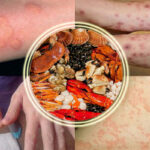[dropcap] 1 [dropcap] Why seafood can be poisonous if not kept cold enough

Changing the storage temperature of seafood from frozen to chilled can increase the production of histamine-producing bacteria (from 0.8 to 104 mg/kg). Histamine is heat-resistant and is not destroyed even when cooked. Therefore, seafood with high histamine content can cause food poisoning when consumed.
[dropcap] 2 [dropcap] Symptoms of eating poisoned fish
– Increased saliva production, stomach fluid secretion, nausea, and diarrhea.
– Red rash, itching, and possible skin eruptions.
– Red eyes, difficulty breathing due to airway swelling and constriction.
– Rapid pulse, low blood pressure due to vasodilation.
– Dizziness, headache, etc.
[dropcap] 3 [dropcap] How to handle poisoned fish
– If you experience any of the above symptoms after eating seafood, seek immediate medical attention at a healthcare facility.
– In case of mild symptoms (skin allergies, digestive disorders), take antihistamine medication.
– In severe cases (low blood pressure, rapid pulse…), immediate resuscitation, first aid, and transfer to the toxicology department for examination and treatment are necessary.
– How to choose safe seafood: Seafood should be fresh, with clear, black eyes, and firm flesh. It should be stored at the appropriate temperature and purchased from a reputable frozen food supplier.

[dropcap] 4 [dropcap] How to store fish
– During transportation and storage, fish should be kept at cold temperatures (from 0°C to below 18°C).
– To limit the increase in histamine levels in seafood, consumers need to adopt proper thawing methods. Thawing can be done in a refrigerator at a temperature of 5°C or lower, by soaking the fish in clean water at 21°C, or using a microwave. After thawing, the fish should be prepared immediately and not refrozen.

To prevent histamine-induced food poisoning from seafood, choose fresh fish, buy from a well-refrigerated source, and store it in your freezer. When thawing, use it immediately to prevent spoilage and histamine production, which can lead to poisoning.
For more information:
Reference: alobacsi.com
The Ultimate Guide to Combating Seafood Allergies
 Seafood Allergies’>
Seafood Allergies’>Seafood is a highly nutritious food, but it’s also a common allergen. Reactions to seafood can cause itching, hives, and swelling of the tongue. However, the symptoms can be alleviated with the following natural remedies and dietary adjustments.

































